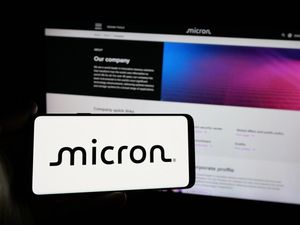Financial News
AMD Defies Headwinds: Analysts Remain Bullish Amidst Soaring 2025 Performance

Advanced Micro Devices (NASDAQ: AMD) has emerged as a beacon of resilience in the volatile technology sector, posting impressive year-to-date stock gains in 2025. Despite navigating a complex landscape marred by geopolitical tensions and stringent export controls, the semiconductor giant has largely maintained a bullish outlook from Wall Street analysts, underscoring confidence in its strategic pivots and robust product roadmap.
The company's significant upward trajectory this year, with gains reported between 32% and 45%, stands in stark contrast to broader market uncertainties. This strong performance, primarily fueled by advancements in artificial intelligence (AI) and data center solutions, signals a pivotal year for AMD as it solidifies its position as a formidable competitor in critical high-growth segments.
AMD's AI Ascendancy and Data Center Dominance Drive 2025 Gains
AMD's remarkable stock performance in 2025 can be attributed to several strategic successes and market catalysts. The year has seen AMD's stock price climb significantly, with shares starting around $120.79 and recently trading in the $159-$161 range by mid-September. This reflects investor enthusiasm for the company's aggressive push into AI and its foundational strength in data centers.
A primary driver has been the enthusiastic reception and ramp-up of AMD's Instinct MI350 series AI accelerators, with the upcoming MI400 GPUs already creating buzz. CEO Lisa Su has articulated an ambitious vision, forecasting "tens of billions" in annual AI revenue in the coming years. The MI350, boasting up to a 35x performance improvement over its predecessor, the MI300X, is seeing widespread adoption from hyperscalers and AI heavyweights, including Meta Platforms (NASDAQ: META), Microsoft (NASDAQ: MSFT), Oracle (NYSE: ORCL), Tesla (NASDAQ: TSLA), and OpenAI. This underscores AMD's growing credibility and capability in challenging NVIDIA's (NASDAQ: NVDA) long-standing dominance in the AI hardware arena.
Beyond AI, AMD's Data Center segment has been a powerhouse, driven by strong demand for its EPYC server CPUs, including the Zen 5-based "Turin" and future "Verano" processors. This segment reported robust year-over-year revenue growth, climbing 57.2% to $3.674 billion in Q1 2025 and an additional 14% to $3.2 billion in Q2 2025. The Client segment, encompassing PC processors, also experienced a notable resurgence, with revenue surging 67% year-over-year to $2.5 billion in Q2 2025, largely thanks to the latest "Zen 5" AMD Ryzen processors. Even the Gaming segment demonstrated robust growth, with revenue up 73% year-over-year to $1.1 billion in Q2 2025, buoyed by Radeon GPUs and semi-custom chips. Crucially, the development of AMD's ROCm software ecosystem is seen as vital for its long-term competitive stance against NVIDIA's CUDA.
Despite these impressive gains, AMD has navigated significant geopolitical turbulence, particularly the U.S. export restrictions on advanced AI chips to China. These controls have directly impacted the sale of AMD's MI308/MI308X GPUs, leading to an $800 million charge related to inventory and reserves in Q2 2025. The company anticipates a total revenue loss of approximately $1.5 billion for the full year 2025 due to these restrictions, with Q3 2025 forecasts explicitly excluding MI308 shipments to China. Nevertheless, Wall Street remains largely unperturbed, with a consensus "Moderate Buy" or "Buy" rating. Analysts have set an average 12-month price target ranging from $174.18 to $185.77, with some bullish targets reaching $230. Firms like Piper Sandler, Truist Securities, UBS, and Bank of America have all raised their price targets, citing strong AI and CPU demand.
Shifting Sands: Winners and Losers in the Semiconductor Race
AMD's ascendancy in 2025 reshapes the competitive landscape of the semiconductor industry, creating both opportunities and challenges for various players. The most immediate impact is felt by its direct rivals. NVIDIA (NASDAQ: NVDA), the current AI GPU market leader, faces intensified pressure as AMD's MI350 and upcoming MI400 series gain traction. While NVIDIA still commands a dominant market share, AMD's robust performance, bolstered by a rapidly maturing ROCm software ecosystem, is chipping away at that lead, forcing NVIDIA to continuously innovate to maintain its competitive edge.
Intel (NASDAQ: INTC), another long-standing rival, particularly in the server and client CPU markets, also feels the heat. AMD's EPYC server CPUs and Ryzen client processors have demonstrated superior performance and market acceptance, leading to significant market share gains. While Intel is making efforts to revitalize its product lines, AMD's strong 2025 performance suggests a persistent challenge to Intel's traditional strongholds. On the other hand, partners involved in AMD's supply chain, such as semiconductor foundries like Taiwan Semiconductor Manufacturing Company (NYSE: TSM), stand to benefit from increased orders as AMD ramps up production of its high-demand AI and data center chips. These foundries are crucial enablers of AMD's success, and their close collaboration ensures the timely delivery of cutting-edge technology.
However, the geopolitical export restrictions primarily targeting China present a complex scenario for all semiconductor companies. While AMD faces an estimated $1.5 billion revenue loss, this situation also creates a vacuum for domestic Chinese chip manufacturers, albeit with significant technological limitations compared to advanced Western counterparts. Furthermore, companies heavily reliant on the Chinese market for sales of advanced chips may suffer, or be forced to develop "de-featured" versions that comply with export regulations, potentially impacting profitability and market growth. This regulatory environment is pushing all major players to reassess their global supply chain strategies and market engagements.
Industry Shifts and Broader Implications
AMD's journey in 2025 is not an isolated event but rather a microcosm of broader, transformative shifts occurring within the semiconductor industry and global technology landscape. The company's focus on AI and data center solutions aligns perfectly with the overarching trend of an accelerating AI revolution. As AI applications become more sophisticated and pervasive, the demand for specialized, high-performance computing hardware – specifically AI accelerators – is skyrocketing. AMD's success validates the industry's pivot towards heterogeneous computing and the crucial role of software ecosystems like ROCm in fostering open alternatives to proprietary solutions.
The geopolitical challenges, particularly the U.S. export controls on advanced technology to China, represent a significant force reshaping global supply chains and trade policies. This situation is prompting semiconductor companies to seriously consider diversifying their manufacturing bases beyond traditional hubs like Taiwan, exploring options in the U.S. and Southeast Asia. Such diversification, while mitigating geopolitical risks, could introduce new cost structures related to labor, logistics, and infrastructure, impacting profit margins across the industry. This move towards 'de-risking' supply chains could lead to significant capital expenditures and strategic realignments for many major players.
Historically, such strategic confrontations between global powers have often spurred innovation in domestic industries. The current tech rivalry between the U.S. and China, particularly concerning advanced semiconductors, echoes past technological arms races. While it creates immediate market dislocations, it also incentivizes national investments in semiconductor research, development, and manufacturing capacity, potentially fostering new technological breakthroughs and strengthening domestic industries in the long term. The regulatory landscape is also evolving, with governments worldwide increasingly viewing semiconductors as strategic national assets, leading to potential subsidies, protectionist policies, and stricter export controls, all of which could reshape market dynamics and competitive advantages.
What Comes Next for AMD and the Market
Looking ahead, AMD's trajectory in the short-term will largely be dictated by its continued execution in the AI and data center segments. The successful ramp-up of the MI350 series and the timely, competitive launch of the MI400 series will be critical for sustaining momentum against NVIDIA. Investors will be closely watching for further adoption by hyperscalers and enterprises, as well as the maturation of the ROCm software platform, which is crucial for developer buy-in and ecosystem growth. In the client and gaming segments, consistent innovation with new generations of Ryzen CPUs and Radeon GPUs will be essential to maintain market share gains against Intel and other competitors.
In the long-term, AMD faces both significant opportunities and challenges. The global demand for AI processing power is expected to continue its exponential growth, providing a vast addressable market for AMD's specialized accelerators. Strategic partnerships with cloud providers and AI developers will be key to embedding AMD's solutions deeper into the AI infrastructure. However, the shadow of geopolitical tensions, particularly regarding export controls, will persist. AMD may need to strategically pivot its product offerings or market focus to mitigate revenue loss from restricted markets, potentially by developing compliant, localized versions of its chips or by intensifying efforts in other burgeoning regions.
Emerging market opportunities lie in edge AI, automotive computing, and further diversification into custom silicon solutions. The growing need for AI inference at the edge creates a new arena for specialized, power-efficient processors where AMD could leverage its CPU and GPU expertise. Potential strategic acquisitions or partnerships could further bolster its technological portfolio and market reach. However, challenges include sustaining research and development investments to stay ahead of the technology curve, managing complex global supply chains amidst geopolitical fragmentation, and navigating intense competition from well-capitalized rivals. Scenarios could range from AMD solidifying its position as a clear number two in AI and a strong challenger across other segments, to facing increased headwinds from an escalating tech cold war that fragments global markets.
A Resilient Ascent Amidst Global Crosscurrents
AMD's performance in 2025 serves as a compelling narrative of strategic foresight and operational resilience in the face of significant global challenges. The company's impressive year-to-date stock gains, driven by its leadership in AI accelerators and robust data center and client segment growth, underscore a successful pivot towards high-growth, high-value markets. Despite the considerable revenue impact from U.S. export restrictions to China, Wall Street analysts maintain a largely bullish outlook, reflecting confidence in AMD's technological prowess and its long-term growth trajectory.
Moving forward, the market will continue to assess AMD's ability to execute on its ambitious AI roadmap, expand its software ecosystem, and navigate the complexities of a fragmented global trade environment. The competition with NVIDIA in AI and Intel in traditional CPU markets remains fierce, demanding continuous innovation and strategic agility. For investors, the coming months will be crucial for monitoring key indicators such as continued AI chip adoption, any shifts in geopolitical trade policies, and the sustained performance of AMD's core business segments. The company's journey in 2025 exemplifies the dynamic nature of the semiconductor industry, where technological leadership, strategic partnerships, and adaptability to macro-environmental shifts are paramount for sustained success and lasting impact.
More News
View More




Recent Quotes
View More
Quotes delayed at least 20 minutes.
By accessing this page, you agree to the Privacy Policy and Terms Of Service.



